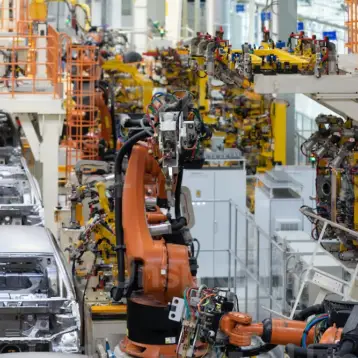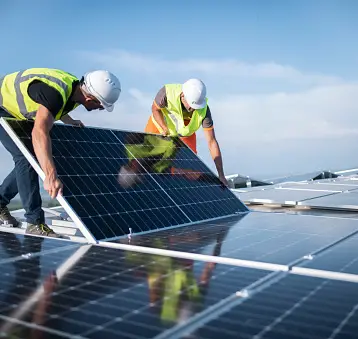The renewable revolution
|
The increased awareness of global warming together with the rising costs of fossil fuels caused a surge of interest in renewable energy resources. There are a number of basic forms of renewable energy: solar, wind, water, biofuel and geothermal. Solar energy can be used in various ways, including photovoltaic cells, which convert the energy into electricity, and concentrating collectors, which focus sunlight to heat a fluid and drive a turbine that produces electricity. Another form of a solar-driven electric power plant is an energy tower that uses the form of a closed greenhouse at the base of the tower to warm air, which rises up the tower, drives a turbine, and produces electricity.
|
Wind is used in specific locations to turn turbines and make electricity. There are onshore, offshore and even newly suggested flying wind farms. Biofuel is a green substitute for fossil fuels, which can be used as a power source for cars or even in power plants to create electricity. Biofuel can be made from a variety of agriculture products, including corn, soybeans, flaxseed, rapeseed, sugar cane, palm oil, and many others.
|
Geothermal energy is used in several locations across the world to either directly drive a turbine and create electricity or boil an organic fluid that spins the turbine. Water is also used at ambient temperatures to create electricity by harnessing the power of the ocean’s waves. Wave farms, as they are known, use the kinetic power of ocean waves to drive hydraulic motors, creating electricity. By far the most common form of renewable energy is hydroelectricity. Hydroelectric energy accounts for well over 50 percent of the world’s renewable energy. In the U.S., hydroelectric power accounts for about 7 percent of the entire energy generation. All other forms of renewable energy combined reach barely 2 percent.
|
Each form of renewable energy has its advantages and disadvantages. Hydroelectricity can generate large amounts of power but it is expensive and complicated to build, and recent studies have shown it has a negative impact on surrounding aquatic ecosystems. For this reason very few hydroelectric power stations have been built in recent years (most hydroelectric projects today are being built in China). Wave farms have very little environmental effect but they are still in their infancy; with only a handful of commercial projects available worldwide, they also tend to produce only a limited amount of power. Wind farms have become one of the more popular alternative renewable energy sources of recent years. They can produce a fair amount of power and have only a moderate impact on the environment, although some people find them to be noisy and nonaesthetic. The biggest problem with wind farms has to do with the unreliable nature of the wind, which cannot always be relied on as a main source of power.
Solar energy has also received a boost in recent years. Despite its growing popularity, solar power has several key disadvantages, the most significant being the inability to produce energy at night. Photovoltaic cells also have some specific disadvantages, including a high price, low efficiency, and the need for a large space.
|
A lot of research is currently going into improving biofuels in order to allow them to replace existing fossil fuels. Although several countries worldwide are already using different forms of biofuel extensively, using it on a very large scale requires a great deal of space, and it is labor intensive. Some critics have also suggested that in developing countries where a majority of people are farmers, simply moving to large-scale production of biofuels might lead to a rise in food prices.
Geothermal sources can produce a fair amount of power (about 50 percent of Iceland’s energy comes from geothermal power), but they usually require natural steam fields, which are not very common around the world, limiting the usage of the earth’s internal heat.
The solar heat pump electrical generation system
|
As we have seen, most renewable energy sources have limitations, and a wind turbine that is right for a community living near a windy seashore is not necessarily right for a community located far inland. Robert Rohatensky, an IT system analyst with an agricultural background living in Western Canada, faced this exact problem as he looked for a way to build a renewable power plant for his climate. He examined various alternatives and decided that none of them fit his needs. Instead, in August 2006, he began to design a new system that combines severable existing concepts, mainly solar and geothermal, to create one unique system called the “Solar Heat Pump Electrical Generation System” (SHPEGS).
The SHPEGS design is composed of several subsystems and a number of stages meant to increase the energy output of the system. The first stage of the SHPEGS is composed of anhydrous ammonia (NH3) stored as a liquid under pressure at an ambient temperature. Pressure released from the NH3 is used to drive a fan, located inside a 100-meter, or 333-foot, tower, which forces air through the heat exchanger, increasing its pressure and temperature. The air is compressed and its temperature rises. The NH3 is then completely expanded to a low pressure in a heat exchanger, or evaporator, and boils at -33C, or -28F (ammonia has a considerably lower boiling point than water). The heat from the air (at the increased temperature) is transferred into the evaporating ammonia. The water vapor in the air condenses as it is cooled and is captured. The heated NH3 vapor at a low pressure is then absorbed into cool water. A pump is used to pressurize the aqueous ammonia liquid back to its original pressure of 400 psi. Since the water and ammonia are now in a liquid state, only a relatively small amount of energy is needed to repressurize the solution.
|
|
We are left with a pressurized water-and-ammonia solution, which is now heated by conventional solar collectors (concentrators) to about 400C, or 752F. After a few more steps, the heat from the hot water and the ammonia condensation is used to drive a steam turbine, which produces electricity. Cold water cools the steam turbine and the heat is transferred to underground thermal storage. The ammonia then returns to its original storage at high pressure to be reused in the next cycle.
|
According to Rohatensky, this complex system (explained step by step in this PDF document) is an amalgamation of several existing power-generation technologies, including solar electricity generating systems (SEGS), ocean thermal energy conversion (OTEC), solar towers, water spray down draft towers, low temperature geothermal systems, and shallow thermal storage. Additionally the SHPEGS has some new, unique ideas and improvements in efficiency, location independence, and reliability over these systems when deployed separately.
When coming right down to it, SHPEGS is a design for a clean renewable power plant that primarily uses solar energy and temperature differentiation to create electricity. How much electricity? Rohatensky and his team of half a dozen experts estimate anywhere between 11MW and 53MW (in the summer). This is not going to replace a multigigawatt power station but might be ideal for more rural areas that currently don’t have other clean alternatives.
Cost is always an issue when planning a big project. Rohatensky has model calculations for a midsize SHPEGS and targets the cost at around $10 million for a production system of this size. Is this cost-effective in terms of existing electricity prices? Rohatensky and his team believe that it is, and that it can actually return the investment in about 10 years, not to mention make our environment cleaner. Rohatensky also noted that the system can be scaled down to much smaller implementations and significantly lower costs.
One of the most interesting aspects of SHPEGS is the idea to make it an open-source project. Although only half a dozen people so far have actually joined Rohatensky, he has already received about 100 inquires from people offering their assistance, and he hopes that more media coverage will help him more quickly complete the research stage.
Open-source engineering
|
Open-source programming is not a new concept; its roots dates back to the 1960s and the development of operating systems such as Unix and, later on, GNU and Linux. The rapid development of the Internet in the 1990s accelerated this work on these and other open-source programming projects, allowing millions of people around the world to take part in the creation and improvement of free software.
Unlike software that requires only man-hours to produce, creating a working power plant in the real world requires expert feasibility studies, government permits, land, and a whole lot of money. So in what sense could the SHPEGS be an open-source engineering project? The answer has to do with the current research state of the project. Since SHPEGS incorporates many existing ideas into one big project, there is extensive work to be done on the many technical aspects. Instead of relying on a small team of engineers to solve the problems and come up with ideas, SHPEGS encourages people from around the world to offer new ideas and possible solutions. According to Rohatensky, there are many portions of the project that require other diverse skills, ranging from administration, project management, software and web development, marketing, and financial organization.
The success of many open-source projects to date had to do with the fact that people contributing to the projects saw direct, and in some cases immediate, rewards for helping the project. A programmer using Linux who needed a certain feature that did not exist in the current release of the OS could work with other people facing the same problem to create an add-on. The add-on might then be added to the next release of the OS to be used by the entire community. In engineering projects such as SHPEGS, no direct personal reward exists, apart from the subjective feeling of contributing to the community; however, since SHPEGS is a renewable energy project, supporters know that their work might eventually help, if even in a small way, save the environment. This form of online volunteering is not that rare—distributed computing projects such as SETI@home and Grid.org involve hundreds of thousands of people looking for extraterrestrial intelligence and life-saving drugs. SHPEGS is a considerably smaller project but the idea is still interesting, and even a relatively low response might prove to be more than enough to complete the research stage.
Rohatensky recognizes that the open-source idea isn’t easy to explain. According to him, most of the code now going into the Linux kernel is from paid programmers working at businesses that have leveraged off the existing code base. The idea of open-source engineering is to manage the large project and design in an open manner and also work with individual, commercial, and academic ventures that have something real to gain from the system and being part of the project. Cleaner air and sustainable power are motivations, but as the project moves forward there are some very concrete reasons why someone would want to work on it.
|
An example supplied by Rohatensky is the architectural student using some of the SHPEGS ideas for his thesis on a plan for an urban sustainable community. The SHPEGS project gives him a jump-start on his design and he promises to add his plans and drawings to the project when they are complete. Another example would be a manufacturing company providing resources to the project to open new markets for its products. Yet another example is the chemist working with the SHPEGS project to develop a related but separate idea that is mutually beneficial to both projects.
Rohatensky expects that if the project hits “critical mass” with a strong potential for success and enough exposure, there will be many contributions from small engineering and design firms that will contribute work to use the project to advertise and promote their firm.
Interview with Robert Rohatensky
TFOT recently interviewed Robert J. Rohatensky to learn more about the current and future state of the SHPEGS project.
Q: How was the project born?
A: I live in Western Canada in the middle of the Canadian prairies. Locally, besides oil and gas, agriculture is the major industry, and due to the continual inflation caused by fossil fuel supply and demand it has become an unfeasible business. I am an urbanized farmer and although my family owns substantial farmland and has for five generations, it is leased out and I work in I.T. In August 2006, as the U.S. ethanol focus was entering the news, I realized that unless agriculture was moved towards renewable energy, ethanol and biodiesel were actually going to make the fossil fuel supply and demand issue worse and not better.
I believe that large agricultural machinery can be converted to electricity much more readily than passenger vehicles. Large tractors already weigh 20 tons, have low travel speed, and remain relatively close to the farmyard. The technology for large electric equipment—locomotives, mining trucks, submarines—exists, but diesel-powered farm equipment has proliferated due to cheap fossil fuels.
I set out to design a renewable electric power generation system that could be scaled to provide the electricity for an average-size Canadian farm to be self-sufficient. In a moderate climate like Western Canada, the existing renewable power systems aren’t adaptable. In this northerly dry location, we have long high–solar isolation days in the summer; but six months of the year is below freezing, and at the winter solstice, we only have eight hours of low-angle sunlight. Wind turbines are at best 10 percent supplemental due to the unreliability; there is limited new hydroelectric potential and we are thousands of kilometers from an ocean, so tidal and wave power aren’t an option. The low winter temperatures also mean that a very substantial amount of energy is spent on structure heating.
The design focus became to design and build a system that uses a combination of direct and indirect solar collection to generate electricity and store thermal energy in an economical, environmentally friendly, scalable, reliable, efficient, and location-independent manner using common construction materials.
The system design is adaptable to other environments, but the focus has been to build a system that would allow a farm to produce food and ethanol/biodiesel with its energy inputs from a renewable source.
Q: Could you describe the SHPEGS project, formally known as the “energy tower”?
A: The project was rebranded to “Solar Heat Pump Electrical Generation System” (SHPEGS) to more accurately reflect the system design. At the most basic level, I think the quote from the SHPEGS site explains it as well as I can.
The main focus of the design is to build a feasible renewable base-load power station for moderate climates like Western Canada, where there is high solar isolation during the summer but very cold temperatures and little daylight in winter. Geothermal power plants are a proven technology to provide base-load electrical power generation. To allow a geothermal-type system to be location independent and to have the thermal source very close to the system, a massive solar water heater is built to heat a very large amount of underground thermal storage during the summer months. Power is generated while heating this thermal storage in the summer, and becomes a very efficient geothermal power system in the winter due to the close location of the thermal storage versus a deep geothermal source and the cold winter climate. To improve performance of the solar thermal system, the solar heat is used to power a heat pump that transfers a much larger amount of heat from the warm summer air. The cold winter temperature allows for cooling a very large mass to subzero temperatures in the winter and provides efficiency in the summer power generation.
SHPEGS is very similar to a binary geothermal power plant. A geothermal power plant generates power by the difference in temperature between hot water deep in the earth and the cooler surface water or ambient air. The SHPEGS system generates power by the difference in temperature between concentrated solar collectors and the earth in the summer and the heated earth and cold air in the winter. The convection tower is secondary power generation and is an efficient method of transferring heat to and from the air, but the main power generation is much the same as a binary geothermal power plant.
Because the system is always moving heat from hot to cold—warm summer air to cold ground—the heat pump is always energy positive, like a steam engine. This is a major stumbling block for a lot of people due to the commonness of cooling-type heat pumps, AC or refrigerator, that are doing the opposite, moving heat from a cold area to a warmer one, and using energy.
The additional heat the heat pump can move is dependent on the temperature difference of the ambient air and the cold store and also related to the latent heat (heat of evaporation) of ammonia. The water portion of the aqueous ammonia doesn’t take a lot of heat, and the heat that it takes to boil the ammonia back out of the aqueous ammonia solution is close to the same as the heat it took to evaporate it in the
air exchangers.
In a scenario where the ambient air was the same temperature as the cold store, the amount of additional heat the solar panels could move would be 2:1. That is, for every watt of heat extracted from the air, it would take 1 watt from the solar collectors to boil it back out again. The output would be the combined heat of 2 watts. Friction in the system adds heat and isn’t a loss; the major losses are going to be heat
dissipation from the transfer pipes and the energy expended in the solution pump, both of which are minimal.
If the ambient air is warmer than the cold store, the heat from the ammonia warms the water as it is being absorbed and the system can move additional heat. The effect is that the heat from the air “preheats” the aqueous ammonia solution, and this requires less heat from the solar collectors. In a scenario where the ambient air is +30C and the cold store is 0C, it should be possible to move three to four times the solar-collector heat from the ambient air; and there are engineering papers claiming much higher multiples (10x–40x), but I haven’t seen any commercial systems proving those numbers.
Q: Could you describe in more detail SHPEGS’ summer/winter operation?
A: Summer – Anhydrous ammonia from pressurized storage is expanded in an evaporator in the top of a convection tower. The pressure of the ammonia drops and it boils at -33C. The heat from the ambient air is transferred into the vaporizing ammonia, and this cools the air, increasing its density as well as condensing any water vapor in the air. The negative buoyancy of the cooler and dryer air causes it to fall down the convection tower. A small amount of power is generated in the tower with a wind turbine.
The ammonia vapor is heated to close to the ambient air temperature, and it is then mixed with cool water. The water absorbs the ammonia vapor, and the heat from the ammonia is transferred into the water. This absorption creates an aqueous ammonia mixture, and its temperature increases as more ammonia is absorbed until it is saturated. A solution pump pumps the aqueous ammonia mixture to a higher pressure (this is a liquid pump, and the energy required is low due to the relative low volume and noncompressibility of liquids). The aqueous ammonia solution is then heated with heat from concentrated solar collectors and the ammonia boils off. This step is fractional distillation, and the majority of input heat goes into boiling the ammonia; the temperature remains relatively constant while the ammonia is boiling, and the water does not take much of the heat. The ammonia vapor is condensed at a heat exchanger (still under the pressure from the solution pump) and returned to storage. The remaining water is cooled in another heat exchanger and returned to the cycle.
A low-boiling point fluid steam turbine, similar to binary geothermal or heat recovery turbines, is coupled between the hot heat exchangers and cold media from underground storage. The steam turbine generates electricity and transfers the heat to the underground thermal storage through this secondary media (glycol or other liquid antifreeze). Although the temperature at the water and then ammonia condensers is lower than the concentrated solar, it is much higher than the ambient air. All of the heat extracted from the ambient air plus allof the heat collected from the solar collectors is available for the power generation.
Winter – Heat is extracted from the underground thermal storage and powers the low-boiling-point steam turbine and generates electricity. The steam turbine is cooled with heat exchangers in the lower portion of the convection tower and this causes the air in the lower portion of the tower to become warmer and less dense and rise in the tower due to buoyancy. Some of this convection energy is captured in a wind turbine and generates some additional electrical power.
Q: How do you keep the underground water thermal storage from losing heat without spending energy?
A: Although there are several options for the thermal storage system, the borehole thermal storage system used at Drake Landing is compatible with the SHPEGS system.
The target temperature would be 80–90°C at the end of summer and -10°C at the end of winter. The SHPEGS system is a little different than the home-heating system at Drake Landing because for efficiency in the steam turbine, you want to always have the largest possible temperature difference, and a more involved zoning system would need to be developed to obtain this criteria. The SHPEGS project has had an offer from a specialist in designing underground thermal storage to develop models for the system, but if the thermal storage is deep enough that the thermal plume doesn’t react with the ambient air, the loss is only through conduction at the horizontal boundaries, and it should be possible to utilize more than 50 percent of the stored heat with a properly designed, zoned thermal storage system.
Q: How is SHPEGS different from similar projects suggested in the past?
A: As far as convection tower ideas, the previous ideas were only feasible in arid locations. Solar steam plants are established technology in arid locations, and both the solar updraft tower and water spray downdraft tower are much less efficient and feasible than existing SEGS/CSP plants.
The SHPEGS system is based on geothermal technology. The difference is that it doesn’t require access to a sufficiently hot existing geothermal source or expend a lot of energy pumping deep geothermal water, but exploits the fact that the shallow earth remains a relatively constant temperature throughout the year. Solar energy provides the heat source in the summer, and rather than dumping this heat back into the atmosphere as in a traditional steam power plant, this heat is stored until the ambient air is much cooler and then used to generate more power.
Q: How much power will SHPEGS generate?
A: A design focus of the SHPEGS project is to be scalable in both directions, and it is designed around common construction materials and systems. I believe that something as important as electrical power should be designed in a distributed fashion similar to the Internet. Many smaller grid-interconnected power stations are a much more reliable system than mega-project single-point-of-failure large power stations. The location independence and renewable energy source mean that the SHPEGS system can be deployed in medium-scale megawatt-size plants, rather than single gigawatt-size plants, with the systems grid interconnected for reliability and security.
- Summer wind turbine electrical output: 4.8 MWh/day (constant)
- Summer heat recovery turbine output: 53MWh/day
- Total summer electrical output: 58 MWh/day
- Winter electrical output: 26 MWh/day
- Thermal storage: 2.6GWh of heat/day (summer)
- 100-meter tower
- 26,400 m2 trough concentrated solar collectors
- Large thermal storage (vertical bore-hole 100m deep 1km x 1km=100,000,000 m3)
Q: How much will SHPEGS cost to build, and why hasn’t anybody built it so far?
A: Once the project is past the demonstration and pilot-project stage, the cost and energy output of the plant will be very similar to the SEGS/CSP solar thermal plants at Kramer Junction in the Mojave Desert and the Solar One project in Nevada. The massive thermal storage of the SHPEGS system has high value for structure heating in Canada, and the solar heat pump, convection tower natural flow/supplementary power generation, and local thermal storage enhancements will allow the system to become cost competitive with fossil fuels as the system components and installations become a commodity. The system already has an advantage in that almost all of the individual components exist in industry and don’t require R&D and custom manufacture.
It’s very early in the project to be accurate on costing, and one of the major reasons for the open design is to have competition in manufacturing and construction early in the system to hopefully lower costs. The system can be scaled up or down readily, so assuming the model system we have calculations for and assuming that the system will be providing electricity and structure heating to an existing farm or business and not selling it at wholesale prices, retail electricity pricing can be used.
A model system producing 2.4 MW summer and 1.1 MW winter with a 100m tower and 250,000 m2 of solar collector operating continuously would be 58MWh/day summer and 26MWh/day winter. The current retail electrical price locally is $0.09/kWh ($90/MWh). This system will generate $5,220/day of electricity summer and $2,340/day winter, which is around $1.3 million.
A reasonable capital investment return, without subsidies, would be 10 years, and I believe that a plant of this size could be built for $10 million, although the first few implementations will probably have a cost several times that until manufacturing and installation efficiencies are developed.
The project has to go through the demonstration/pilot stage to have anything better for cost projections.
Q: Why did you choose an open-project model, and do you see more groups embracing this concept for other engineering projects?
A: It is far from the first project of its kind. Historically, the development and sharing of ideas in a community for the common good has a precedent. The industrial revolution and fossil fuels have skewed that philosophy, but open design is far from a new idea. I believe there is substantial entrepreneurial opportunity in subcomponent design and manufacture, system installation and construction, engineering in specific adaptations, and in operating the system and selling energy products. The relatively low R&D of the system should allow commercial ventures to develop business plans around this system without controlling intellectual property.
Why I would put effort into this without obtaining patent protection is much the same as why I expect other ventures to assist with the project. The main project is large and long-term, and I would like the information and the general system design to remain available for the common good. My hope is that the overall project succeeds, and I intend to pursue an entrepreneurial venture based on my specific skills in IT system design, GIS modeling, and consulting in agricultural SHPEGS implementations and integrations.



















